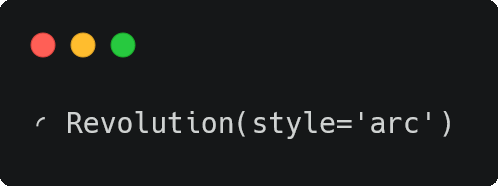An assortment of spinners to use while your Python programs run.
Project description
revolution



An assortment of spinners to use while your Python programs run.
Installation
In order to install revolution, run the following in your command line:
pip install revolution
revolution doesn't have any dependencies.
Usage
In order to use revolution in your code, importing it is as simple as:
from revolution import Revolution
Parameters for Revolution()
The parameters for instantiating a Revolution object are as follows:
Revolution(func=None, desc='', total=None, style='', safe=True, interval=None)
func
The func parameter should be left blank unless you initialize a Revolution object with a range object or a list.
desc
The desc parameter accepts a string object that will be displayed alongside the visual spinner.
total
The total parameter accepts an integer value that will be used as the total number of expected iterations.
style
The style parameter accepts a string object that will be used to specify the spinner style. If style is None or if it doesn't exist, the classic style will be used.
safe
The safe parameter accepts a bool value that will use a spinner style that is safe for terminals on Windows machines.
interval
The interval paremeter accepts a float value indicating how often the spinner should refresh.
Function decorator
revolution can be used as a function decorator:
from revolution import Revolution
@Revolution
def do_something():
for _ in range(10):
pass
do_something()
You can also provide it a description while you wait for your task to finish:
from revolution import Revolution
@Revolution(desc='Just passing time...')
def do_something():
for _ in range(10):
pass
do_something()
with statement
Another possible way to implement revolution is through the use of a with statement:
from revolution import Revolution
with Revolution(desc='Running through numbers') as revolution:
for _ in range(100):
revolution.update(1)
You can also include a visual counter by including a total:
from revolution import Revolution
with Revolution(desc='Counting up to 100', total=100) as revolution:
for _ in range(100):
revolution.update(1)
for loop
If you give a Revolution object a range object or a list, you can then iterate over it:
from revolution import Revolution
total = 0
for i in Revolution(range(100)):
total += i
print(total)
General
Finally, you can use revolution by manually controlling when to stop it:
from revolution import Revolution
revolution = Revolution(desc='Doing things...')
start_long_task()
revolution.stop()
Styles
There are multiple built-in spinner styles that you can take advantage of. However, only the classic spinner will be used on Windows machines unless you set safe=False when you initialize a Revolution object.
classic
Revolution(style='classic')

- Windows-friendly
- If a Revolution object doesn't contain a specified style, this is the style that it will default to
dots
Revolution(style='dots')

- Windows-friendly
equal
Revolution(style='equal')

- Windows-friendly
braille
Revolution(style='braille')

braille_long
Revolution(style='braille_long')

braille_crawl
Revolution(style='braille_crawl')

braille_bounce
Revolution(style='braille_bounce')

arc
Revolution(style='arc')

clear_quadrants
Revolution(style='clear_quadrants')

Project details
Download files
Download the file for your platform. If you're not sure which to choose, learn more about installing packages.
Source Distribution
Built Distribution
Hashes for revolution-0.1.2-py3-none-any.whl
| Algorithm | Hash digest | |
|---|---|---|
| SHA256 | 0b718f7a81f25776a1fbff53d3824f0f4b6c4f7bfc941624128f7fd92f961f65 |
|
| MD5 | d6a764e79477309ced4725ea9d2cf27f |
|
| BLAKE2b-256 | 1e0dfdcd94638252def884d0bcc502f0191ac6496a26a180dbf8ff2a2141658c |












